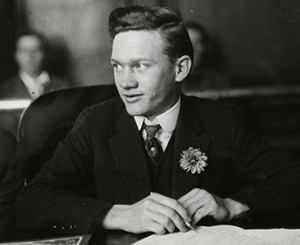
Warren Billings served a short sentence for transporting explosives during the PG&E strike. He was later framed for the Preparedness Day bombing. SFHC/SFPL
During the summer of 1913 PG&E petitioned for an injunction against the strikers, claiming that linemen were using rubber gloves and insulated pliers to disconnect lines.
“Although we repair the cutting of the wires by unknown persons every day and make a test afterward, the wires are cut again before time to turn the lights on,” said a company spokesman.
The day after PG&E filed its lawsuit, strike leader W. S. Junkin said the Light and Power Council was willing to give up its one remaining demand—union recognition. Britton rejected this olive branch.
The strike continued to attract labor militants with no connection to PG&E. Warren K. Billings, a youth from the New York Catskills, was hired by IBEW Local 151 to patrol PG&E’s major power lines by motorcycle. His job was to figure out where the lines were well guarded—and where they were not. Billings also had a talent for helping dynamite walk away from construction projects.
In September, Edgar Hurley, an IBEW 151 officer, apparently offered Billings $25 to carry a suitcase with 60 sticks of dynamite to Sacramento. (Hurley later denied any involvement.) Billings was busted in Sacramento by a Pinkerton agent named Martin Swanson, who tried unsuccessfully to implicate Billings in a conspiracy to blow up a PG&E steam plant north of Sacramento. Billings was convicted on lesser charges and served a brief sentence.
Late in the fall of 1913, a friend of Billings named Tom Mooney was arrested on charges of plotting to blow up a PG&E transmission tower, but three separate juries refused to convict him.